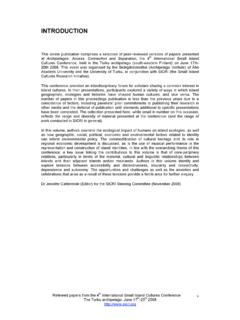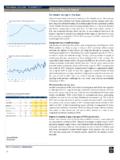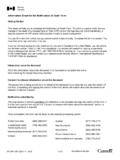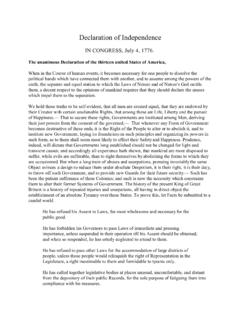Transcription of TYPOLOGY OF CULTURAL TOURISTS: AN ISLAND STUDY
1 Yun, D et al (2008: 101 111) TYPOLOGY of CULTURAL Tourists TYPOLOGY OF CULTURAL TOURISTS: AN ISLAND . STUDY . DONGKOO YUN, SEAN HENNESSEY, ROBERTA MACDONALD and MELISSA MACEACHERN. (Tourism Research Centre, University of Prince Edward ISLAND , Charlottetown, Canada). Introduction Many research studies suggest that a substantial percentage of tourists seek CULTURAL experiences, such as visiting CULTURAL attractions and participating in diverse CULTURAL activities that are not sun, sand and sea' related. The World Tourism Organization suggests that more than 40% of all international tourists are CULTURAL tourists' (Richards, 1996). The Travel Industry Association of America has estimated that two-thirds of adults visit a CULTURAL or heritage site or attraction when they travel (Silberberg, 1995).
2 Based on this data, it has been argued that CULTURAL tourists represent a new type of mass tourist who seeks meaningful travel experiences (McKercher and Du Cros, 2003). There is little doubt that culture is an important part of the tourism product' and is one of the factors that can improve the competitiveness of a tourism destination. An examination of the forces shaping the CULTURAL product' will help identify the reasons why CULTURAL tourism is critical at destinations. For this STUDY , CULTURAL tourism covers all aspects of travel where visitors can learn about another area's history and way of life. Thus, CULTURAL factors in the context of tourism include the entertainment, food, drink, hospitality, architecture, and manufactured and hand-crafted products of a destination, and all other characteristics of a destination's way of life (McIntosh and Goeldner, 1990).
3 McNulty (1991). and Weiler and Hall (1992) consider culture to include family patterns, folklore, social customs, museums, monuments, historical structures, and landmarks. Others include wilderness areas, valued landscapes, natural history buildings, and artifacts as part of CULTURAL tourism (Tassell and Tassell, 1990; Prentice, 1993). Tourists travel to be informed and to experience folklore, customs, natural landscapes and historical landmarks as well as being involved in other activities such as nature, adventure, sports, festivals, crafts and sightseeing (MacDonald and Jolliffe, 2002). In addition, many activities at destinations that are not educational or CULTURAL in a narrow sense provide opportunities for tourists to get to know each other (Richards, 1996).
4 However, it has been difficult to demonstrate how important CULTURAL tourism and CULTURAL tourists are for a specific destination. Who are the tourists that visit CULTURAL attractions or engage in CULTURAL activities, and why? What specific travel behaviours make them distinct from other travellers? How large is the demand for CULTURAL tourism and what elements of culture attract tourists? How can CULTURAL tourism be successfully developed and promoted? The answers to these types of questions may be quite different among destinations due to the different elements that create the culture of each destination. This paper's objective is to examine the meaning and significance of CULTURAL tourism on Prince Edward ISLAND .
5 In doing so, the paper attempts to identify CULTURAL tourists and profile trip characteristics of CULTURAL tourists in an ISLAND setting. What Is CULTURAL Tourism? The terms CULTURAL tourism' and CULTURAL tourists' are widely used, but also misunderstood. In addition, the definition of CULTURAL tourism and CULTURAL tourist remains vague (Aluza, O'Leary and Morrison, 1998). Academics, practitioners, and policy-makers have been quick to identify CULTURAL Refereed papers from the 3rd International Small ISLAND Cultures Conference Institute of ISLAND Studies, University of PEI, June 29 July 2, 2007. - 101 - Yun, D et al (2008: 101 111) TYPOLOGY of CULTURAL Tourists tourism as a significant and growing market, but have been hesitant or unable to describe and define the market.
6 Most attempts at defining CULTURAL tourism agree that it consists of the consumption of culture by tourists (Richards, 1996). However, this approach also produces new problems because it includes a wide range of CULTURAL elements. For example, what kinds of CULTURAL experiences should be included within the scope of CULTURAL tourism? Does a three-hour visit to a museum turn an entire two-week holiday into a CULTURAL tourism experience? Are tourists who engage in CULTURAL activities initially motivated to travel because of CULTURAL attractions? Or, do they find out about the CULTURAL product after arriving at a destination and engage in the activity for something to do'? It is clear that defining CULTURAL tourism and CULTURAL tourists is complex because it can mean different things to different people (McKercher and Du Cros, 2003).
7 For many tourists, travelling to experience different cultures equates to CULTURAL tourism. For these travelers, encountering different cultures is synonymous with a CULTURAL tourism experience. They consume the different sights, sounds, tastes and smells of an unfamiliar culture. On the other hand, academics and tourism marketers define CULTURAL tourism as a discrete product category that is differentiated from other tourism activities or attractions by consumption of a destination's tangible and intangible CULTURAL heritage (Richards, 1996; Shackley, 1998; Hall and MacArthur, 1998; Leask and Yeoman, 1999). A growing body of literature indicates that some people are more highly motivated to participate in CULTURAL tourism than others.
8 McKercher (2002b) suggests that a definition of CULTURAL tourists can be developed by considering two issues: the main reasons for a trip and the level of experiences at the destinations. A number of both conceptual and empirical studies have attempted to implement this process and explore the TYPOLOGY of CULTURAL tourists. Silberberg (1995) identified four types of CULTURAL tourists, ranging from the greatly motivated to the accidental, while Shifflet and Associates (1999) identified three types of heritage tourists: core', moderate' and low', with each of the segments demonstrating different behaviour and spending patterns. Stebbins (1996) suggests that the CULTURAL tourist comes in two types: general' and specialized'.
9 The general CULTURAL tourist makes a hobby of visiting different geographic sites. Over time, as general CULTURAL tourists increase their knowledge of different cultures, they may become specialized CULTURAL tourists who focus on one or a small number of geographic sites or CULTURAL entities. Aluza, O'Leary, and Morrison (1998) contend that the CULTURAL and heritage tourism market consists of five distinct segments with each having different trip characteristics, suggesting that not all CULTURAL and heritage tourists are alike and should be targeted in different ways. McKercher (2002a) also suggests that CULTURAL tourism can be segmented into five markets based on the depth at which the tourists engage in a culture or a CULTURAL attraction, and how central the culture or attraction was to their choice of destination.
10 To some segments, culture or the attraction played a major role in their decision; while, to other segments, culture played either a minor role or no role in their decision making (McKercher and Du Cros, 2003). Martin et al. (2004) report that CULTURAL and general visitors are very different in terms of activities, expenditures, information sources used and lodging preferences. Their STUDY found that CULTURAL heritage visitors were different from other visitors on most measurements, implying that heritage planners and marketers should take these differences into consideration when planning and promoting CULTURAL heritage tourism. Nyaupane and Andereck (2007) suggest that CULTURAL tourists can be divided into two groups: true CULTURAL tourist ' and spurious CULTURAL tourist '.









